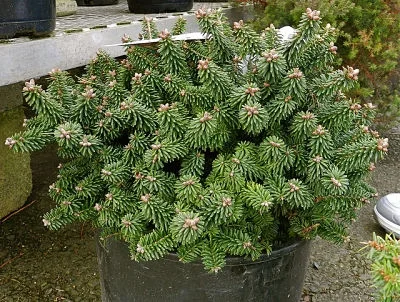Coming up short: Dwarf evergreens
/Dwarf Alberta spruce 'Sander's Blue' F.D. Richards/Flickr
‘Tis the season to appreciate the evergreens in our lives as we prepare to give pride of place to the ever-popular Christmas tree, centerpiece of the holidays.
Many well-intentioned homeowners opt for a living tree with the thought that it can be planted out and live on in their home landscapes. This can be a recipe for heartache, since the trees we typically select as our Yuletide favorites – white pine, Norway spruce and Douglas fir – are really forest trees, destined to grow 60 to 80 feet tall with a spread of 40 feet or so.
The hard truth is that typical suburban properties can’t accommodate too many full-sized conifers. But thanks to the cleverness of breeders and the tenacity of plant hunters, there is an alternative in the growing array of dwarf and miniature conifers that won’t outgrow their allotted space.
As an added boon, this useful class of plants offers surprising variety in color, shape, texture and habit. Dwarf conifers come in an intriguing palette of gold and maroon, steely blue, and every shade of green. If you can live with a pint-sized holiday tree, one of these might make a better choice as a specimen intended to have a post-holiday life outdoors in the yard.
“Dwarf” and “miniature” are relative terms in the conifer world, indicating a plant that grows smaller and more slowly than the species. The American Conifer Society classifies miniatures as evergreen that grow less than 3 inches annually and reach a size at 10 to 15 years of just 2 to 3 feet. Dwarfs grow 3 to 6 inches a year and in the same period grow to heights of 3 to 6 feet. Most top out at around 12 to 15 feet.
Where did these height-challenged conifers come from? Some are native to high elevations with poor soil and fierce winds that stunt plant growth. Some are naturally occurring varieties that grow smaller and more slowly than is typical of their species.
Others are freaks of nature that arrived on a “witch’s broom.” That’s the term for a mutation that sometimes occurs on the branch of a normal tree and is characterized by a tight, dense mass of abnormally small foliage. These supply material from which dwarf and miniature conifers may be propagated and modern-day plant hunters travel the world in search of them.
Bringing plants to consumers is a slow process, since some promising cultivars developed from witch’s brooms will fail in time. At best, root growth occurs in six to 12 months, and development of viable stock can take seven to nine years. The labor-intensive work and the patience required is responsible for the relatively high price of these unusual little evergreens -- $30 to $90 for specimens in standard one-gallon containers, with genuinely rare types costing considerably more.
The value lies in their long life expectancy, enduring natures and low-maintenance ways. A bed of miniature conifers may take some coaxing along, but these plants won’t mount a campaign to conquer the yard. Evergreens add permanence and beauty to a landscape with considerably less fuss than required by a perennial border or a garden of hybrid roses.
Dwarf balsam fir 'Piccolo' Peter Stevens/Flickr
Culture and care
Proof that good things come in small packages, dwarf and miniature conifers are extremely hardy and pest-resistant, and generally easy to maintain.
Most conifers prefer a sunny spot, but several are tolerant of partly shady positions. Spruce, fir and false cypress (chamaecyparis) can thrive in half-day sun and deer-resistant plum yew (cephalotaxus) can take a fairly shady location.
Conifers native to high elevations won’t do well in New Jersey’s hot, humid summers, and those grown in the Pacific Northwest are less likely to tolerate drought and cold typical of the East. Look for plant sources in a climate similar to ours.
The majority thrive in neutral to moderately acid soil and except for swamp species like bald cypress, most want a well-drained spot. Some growers add grit to planting holes or place specimens in raised beds, troughs or sloping locations to guarantee good drainage. Rotted leaves are useful, too, for aerating the soil and can be mixed into the soil.
The best time to plant is spring and early fall, when temperatures are cool and rainfall usually abundant. If hardiness is in doubt, spring is probably the better choice to allow conifers a growing season to establish roots. Try to get a hole dug for Christmas purchases before the ground freezes, or protect the potted tree with mulch and a sheltered location until planting can take place.
Conifers need regular watering for the first season until roots adjust and grow, but thereafter should only require irrigation during droughts. These plants won’t wilt when thirsty, but will indicate by fading color or the browning of interior foliage that they need a drink.
Don’t over-fertilize since it will only accelerate growth in a plant you bought for its compact stature.


